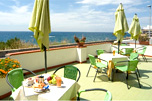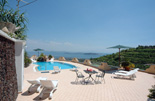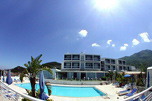
Ischia is the most large island of the Gulf of Naples, it stretches on 47 square meters whose 39 of coasts. Situated in the Tyrrhenian Sea, with the islands of Procida and Vivara, completes the group of the Phlegrean islands.
In addition to the many beaches, large and small, the Island includes green and relaxing pinewoods while country and hills create numerous landscapes ending with the summit of Monte Epomeo, 789m above the sea level. The name Epomeo has an important meaning: seeing from the high side panoramically. The view fades into the immense sea and a breathtaking vista.
Gold mines, so the doctor Jasolino called the thermal springs of the island. Twenty-nine thermal basins which the 103 springs derive from, everyone has healthy properties thanks to the volcanic origin.
People live on tourism while the South and West sides of the island continue to live on farming, harvesting vineyards. Very good wine, first in Italy to obtain the AOC definition, goes well with the island dish of rabbit, which the real islanders celebrate own events with. Another small part of population consists of fishermen, that patiently prepare the fish nets.
Nowadays the island is divided into six municipalities: Casamicciola Terme, Lacco Ameno, Forio, Serrara Fontana and Barano that we meet along our trip around the Island anticlockwise.
Ischia is an ancient town, known in the past for its industry and clay vases, and as Pliny tells, the island was called Pithaecusa. Originally the town raised up where today rises the port of Ischia. During the eruption of 302 B.C. collapsed the ancient suburb, creating the natural lake, turning into the actual port by Ferdinand II Bourbon in 1854. Linked to Ischia through a bridge, near the Castello Aragonese, that for long time hosted the entire population of the island to defend against the pirate invasions.
Casamicciola Terme rises to the North coast of the Island, part on the sea and part on green hill beyond. The built up area consists of small houses and villa, whose hosted Garibaldi during his convalescence to cure in the Gurgitiello’s waters and mud the Aspromonte leg injury consequences. Casamicciola is based on tourist development and the important hydrothermal resources. It enjoys a loving and grateful guests, that every year arrive in like a healthy area for the six winter months.
Going on the beautiful seashore, we find Lacco Ameno. The small town spreads out along the sides of a bustling bay up to the hills all around. To the right the sea seems a large lake, where the famous and peculiar rock, the Fungo, inform the visitor to have reached the destination. Thanks to the good weather, this municipality counts today a high level quality clientele from all the world. Lacco is rich in archeological finds and visits at Villa Arbusto and Basilica di Santa Restituta and its museum..
ThenForio, the most important centre to the West side of the island. Facing to pirates invasions, 16 coast towers were raised up, whose ‘Torrione’is the most eminent. The most favorite municipality by tourists and foreigners, for the attractiveness of its beaches, for the greenery and the natural environment where the beauty, history, tourism and poetry get on well.
In hill, by rural charm, Serrara Fontana is set on 400 m above the sea level, boasting a peasant built up area. From belvedere it’s possible to admire the suggestive beach unique in beauty and the sea by the two sides. On the horizon, Capri and Sorrento. Available excursions and trips, but very interesting is Cavascura, where a rich thermal spring, at the temperature of 100°C, feeds the thermal establishment dug into the rock.
Going on to the South of our trip around the island,Barano arrives, , a typical rural country. It hosts the beautiful beach of Maronti,and its access to the sea; a beach rich in thermal springs, fumaroles and inflamed sand. The famous springs are Nitrodi and Olmitello. Barano is also famous for its ancient dance, one of these is the ‘Ndrezzata,passed on from father to son to keep the past memory alive.





